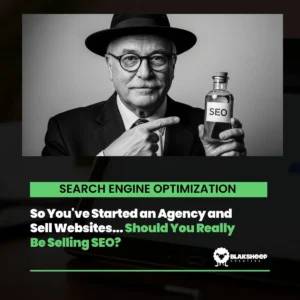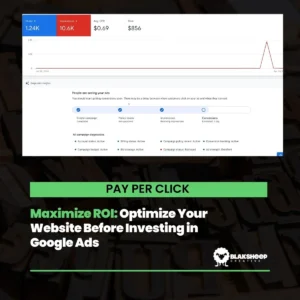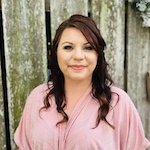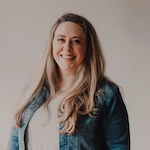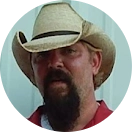Over 86% of digital marketing experts agree that creating a cohesive customer journey is critical. By simply knowing what your potential customers want and need, you can create a personalized experience for them.
But, to do that, you’re going to need to read their minds – a little.
Geotargeting and Geofencing can help you market to potential customers based on their location. By using these two, you can launch successful, laser-focused marketing campaigns that will optimize opportunities and drive more conversions for your business.
And by improving your local marketing efforts, you are guaranteed to increase traffic to your small business.
Read this article to learn more about how you can boost conversions with Geofencing and Geotargeting.
What is Geotargeting?
If you’re a local business, your pay-per-click ads probably don’t need to be seen by everyone on the planet.
It’s more likely that the products and services you’re advertising should be limited to a specific country, city, or city block.
You can do this using Geotargeting.
Geotargeting (also known as local Pay Per Click (PPC)) is a type of location-based marketing that allows you to deliver specific, focused content to a consumer based on their geographic location.
For example, if your business makes sales based on foot traffic (like restaurants, proximity to your location (like new car dealerships by city), and deliveries (like an eCommerce store that ships only to individual countries), then Geotargeting is an absolute necessity.
Using Geotargeting, you won’t waste your ad campaign’s budget on wasted clicks from people who aren’t within your target area.
You’ll increase the chances that the people who do click on your ads can receive your products and services.
Or, to break it down, Geotargeting is essential if you want to get the most bang for your buck in your advertising spend.
How does Geotargeting work?
Geotargeting uses the user’s device’s IP address and GPS coordinates to determine the consumer’s location.
What is an IP Address?
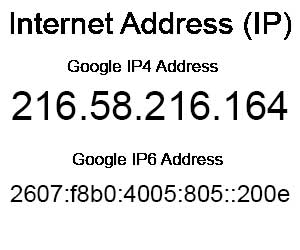
Every device that connects to the internet has its’ own IP (Internet Protocol) address.
Now, we’ll just give you a brief overview without burying you in technical jargon.
There are currently two standards for IP addresses: IP Version 4 (IPv4) and IP Version 6 (IPv6).
All devices connected to the internet have an IPv4 address, and many are starting to use the new IPv6 address system.
So what’s that mean for a business owner trying to use Geotargeting?
Nothing.
Just know that Geotargeting (mobile digital marketing) can help you reach users in specific geographic areas.
Now that you’ve dialed in where your target audience is, you can focus on what they are – their demographics, interests, and even their buying behaviors.
By narrowing your audience down using this real-time location data, you will be able to pinpoint and target those most likely to become customers.
Plus, the more you use Geotargeting, the more understanding you will have of your consumers and their behaviors. Armed with this data, you can create content that’s targeted for specific buyer personas, resulting in more leads and conversions.
- Learn how to create a buyer persona in our recent article, “Digital Marketing Strategy VS. Digital Marketing Plan.”
Geotargeting is not just for content marketing and advertisements.
You can also use Geotargeting to deliver emails or send push notifications on mobile applications.
The most significant benefit of Geotargeting is your ability to personalize your messaging (whatever form it takes). You save time, energy, and money by focusing on the people most likely to become customers.
What is Geofencing?
Much like Geotargeting, Geofencing is also a location-based service.
An app or other software uses GPS, RFID, Wi-Fi, or other cellular data to trigger a pre-programmed action whenever a mobile device or RFID tag enters or exits a virtual boundary set up around a geographical location known as a geofence.
Some of these triggers can include:
- Email alerts
- Text messages or alerts
- Notifications on mobile apps
- Target ads on social media
Although not marketing-related, it’s still worth noting that depending on how they set up their geofence, businesses can use Geofencing to allow tracking on vehicle fleets, disable specific technology, monitor activity in secure areas and see alerts when anyone enters or leaves that area.
Businesses can also use Geofencing to monitor employees in the field, automate time cards, and keep track of company property.
Just like with Geotargeting, you can include or exclude certain users within a target area based on demographics.
Geofencing is perfect if you want to capture all users within a specific area.
Any ads that trigger within a geofence will only display on a device as potential customers are browsing once they enter your geofenced area.
These ads will help consumers become aware of local deals or how far they are from your business.
Although it’s similar to Geotargeting, Geofencing allows you to target your consumers with better accuracy.
For example, a retail store in a shopping mall might want to use Geofencing to capture shoppers as they walk by the store.
Geofencing is perfect for engaging customers based on a local location. This marketing strategy is ideal if you want to make immediate sales or learn more about your consumer’s mindset.
Even if your geofence doesn’t result in a lead, there are still benefits. You’ll still be able to gain valuable information from the consumer to optimize your ads.
Geotargeting vs. Geofencing
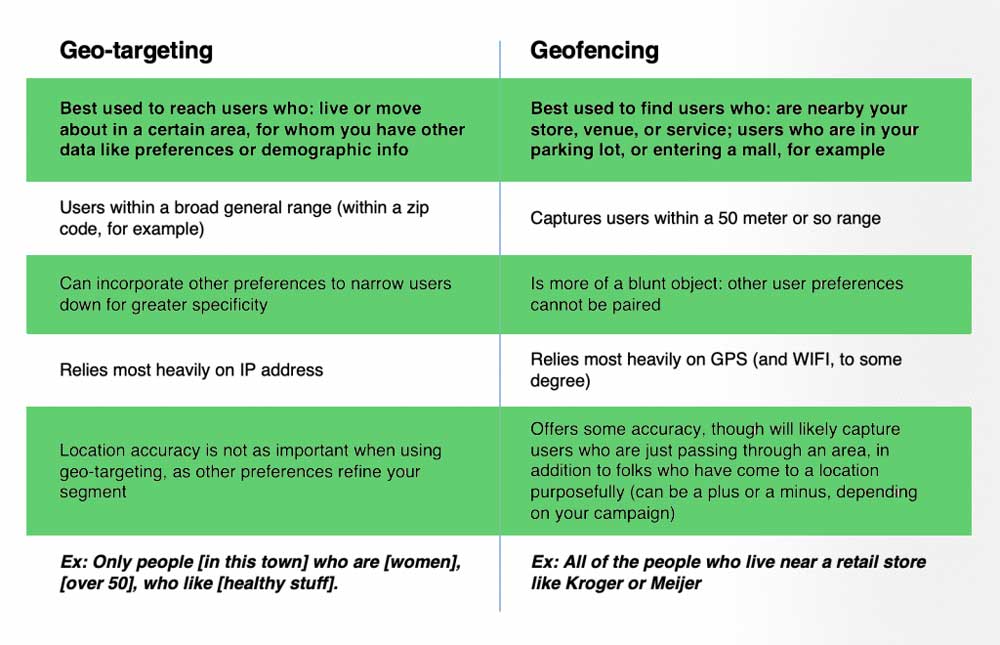
The main difference to keep in mind when comparing Geofencing and Geotargeting is that Geofencing sets up a boundary that triggers certain ads to display when users enter an area.
On the other hand, Geotargeting is more focused on a specific set of users in the vicinity of a geolocation point. Geotargeting can apply a more personalized message to fit the user’s potential needs. At the same time, Geofencing can provide opportunities for those who are moving through the target area that they may not otherwise see.
If you want potential clients to see your targeted message when they come into town for vacation, you could set up a geofence that triggers to send them the desired content once they enter a virtual boundary.
If you want to reach specific individuals who are here on vacation and are hanging around for a few days, you could set up Geotargeting based on the location where they will be.
For instance, since we’re in Baton Rouge:
People are coming into town for an LSU football game – Use Geofencing when they cross over the Mississippi River bridge to the west, the Amite River to the east, The Metro Airport to the north, and Highland Road to the south.
Now while they are here for the game weekend. Use Geotargeting to reach those already in Tiger Stadium (we prefer to call it Death Valley).
Geotargeting is the more straightforward and least expensive of the two to implement and use to target your potential and current customers.
Geofencing, although more difficult, offers a higher chance for a big payoff.
How to use Geotargeting and Geofencing to Increase Your Conversions.
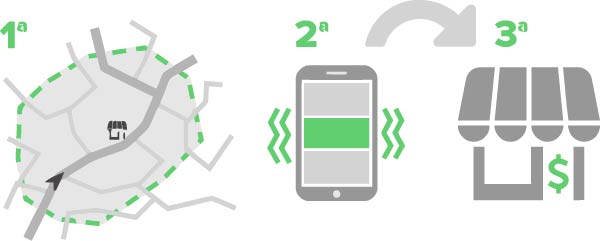
Did you know that 88% of consumers who do a local search on their smartphone visit or call a store within a day?
Understanding how consumers search can help you use Geotargeting and Geofencing to attract people to your business.
Here are five ways you can use both to increase conversions!
1. Match the Language
You’d probably want to make sure the language you use matches the spoken and written communication in the area(s) you’re targeting.
2. Match the Currency
If you list prices on your website or in your ads, make sure the price matches the consumer’s country of origin. Matching the currency will make it easier for consumers to make buying decisions.
3. Match the Location
You can also use location-specific language to make the message more personalized. For example, if you’re targeting consumers in a specific city or zip code, mention the city’s name in your messaging.
You should create location-based landing pages on your website as well!
4. Match the Message
Effective digital marketing hinges on getting the right message in front of the right person at the right time.
With Geotargeting and Geofencing, you can even run different campaigns in different locations at the same time. Do some A/B testing and experiment.
Test out different ad content and see what appeals to your target audience better.
You can also test sending traffic to a geo-targeted landing page versus your website’s home page or a generic landing page to see which converts better.
5. Match the Look and Feel
Your visual elements matter, as well. Test different color combinations and photos. Bear in mind the psychology of colors in online marketing. See the image below for some examples:
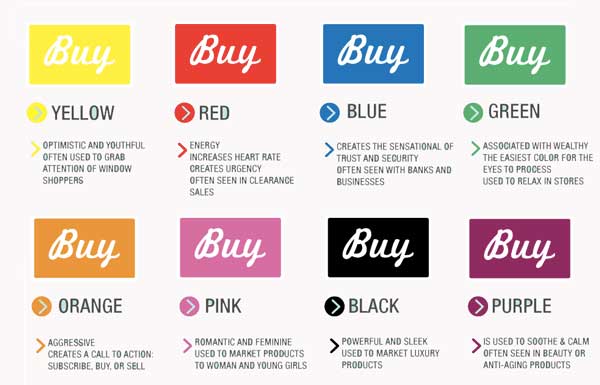
See which appeals more to your target audience to optimize conversions.
For instance, we ran a two-part worldwide Facebook campaign. We discovered that one specific color converted better than any other when used as a simple background.
Geofencing & Geotargeting: Get those Customers When They’re Close!
Don’t let potential customers get away!
Instead, choose the best Geofencing and Geotargeting strategies for your target market to reel them in. Then, you can drive conversions and grow your business!
Ready to get started? Contact us today for a free consultation and discover how we can help! You can even fill out the nifty form below if you want.



